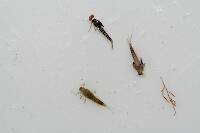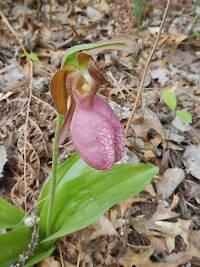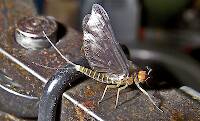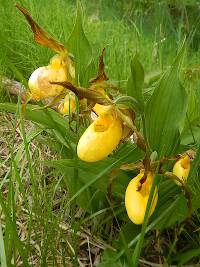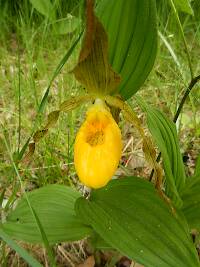
Hex Mayflies
Hexagenia limbata
The famous nocturnal Hex hatch of the Midwest (and a few other lucky locations) stirs to the surface mythically large brown trout that only touch streamers for the rest of the year.
Featured on the forum

With a bit of help from the microscope, this specimen keys clearly and unsurprisingly to Hydropsyche.

Troutnut is a project started in 2003 by salmonid ecologist Jason "Troutnut" Neuswanger to help anglers and
fly tyers unabashedly embrace the entomological side of the sport. Learn more about Troutnut or
support the project for an enhanced experience here.
Dryfly on Jun 14, 2009June 14th, 2009, 3:09 pm EDT
Today I got out to an area stream and fished for a while. There was a hatch of sulfers but no risers at all. There were fish there, as I nymphed up around a dozen. Any similar experiences? Any ideas to why they weren't looking up?
It was around a campground so some kids may have been there before but the fish usually resume after a while. Maybe some streams have fish that simply don't rise. Any ideas?
It was around a campground so some kids may have been there before but the fish usually resume after a while. Maybe some streams have fish that simply don't rise. Any ideas?
Martinlf on Jun 14, 2009June 14th, 2009, 3:21 pm EDT
I once waited for hours on the Firehole in Yellowstone as PMD's and olives hatched but no fish rose. Late in the afternoon, after everyone else had given up and gone home the fish started to eat. I fished alone, where about twenty guys had been previously, and caught fish after fish. I have no idea why those fish waited until they did, but it was an interesting experience.
"He spread them a yard and a half. 'And every one that got away is this big.'"
--Fred Chappell
--Fred Chappell
Softhackle on Jun 14, 2009June 14th, 2009, 3:45 pm EDT
Hi,
You said you took about a dozen on nymphs. In my estimation, you were experiencing something I consider NORMAL. Don't forget, 85% of trout feeding takes place underwater. Trout do not ALWAYS rise to hatching insects. Dry fly fishermen would prefer they do, but it is not a sure thing. It's not as if the fish were not feeding if you took twelve. Perhaps they found it much easier and more biologically economical to feed on the nymphs.
Mark
You said you took about a dozen on nymphs. In my estimation, you were experiencing something I consider NORMAL. Don't forget, 85% of trout feeding takes place underwater. Trout do not ALWAYS rise to hatching insects. Dry fly fishermen would prefer they do, but it is not a sure thing. It's not as if the fish were not feeding if you took twelve. Perhaps they found it much easier and more biologically economical to feed on the nymphs.
Mark
"I have the highest respect for the skilled wet-fly fisherman, as he has mastered an art of very great difficulty." Edward R. Hewitt
Flymphs, Soft-hackles and Spiders: http://www.troutnut.com/libstudio/FS&S/index.html
Flymphs, Soft-hackles and Spiders: http://www.troutnut.com/libstudio/FS&S/index.html
Dryfly on Jun 14, 2009June 14th, 2009, 4:05 pm EDT
Mark, you are correct that almost all trout feeding occurs subsurface. A week ago they rose a lot to the hatch, although on a different stream. It just would seem with the amount a mayflies coming off a fish could find someplace where it could suck them down with little energy expenditure.
During sparse Bwo or Hendrickson hatches I'm used to having fish ignore, but when the bugs are really hatching the fish normally take notice. One thought could be that the day they were rising was overcast and cool so they had so float a lot longer than today. The mayflies that day might have been easier to catch therefore the trout took notice and ate some sulfers. Today was sunny and warm so they were not on the water very long, making them (bugs) harder to catch.
The nymphs were not imitative specifically of the hatching bugs. Black Wet Fly, drowned terrestrial, Prince and Pink Squirrel both attractors. They may have vaguely represented the mayflies.
During sparse Bwo or Hendrickson hatches I'm used to having fish ignore, but when the bugs are really hatching the fish normally take notice. One thought could be that the day they were rising was overcast and cool so they had so float a lot longer than today. The mayflies that day might have been easier to catch therefore the trout took notice and ate some sulfers. Today was sunny and warm so they were not on the water very long, making them (bugs) harder to catch.
The nymphs were not imitative specifically of the hatching bugs. Black Wet Fly, drowned terrestrial, Prince and Pink Squirrel both attractors. They may have vaguely represented the mayflies.
Softhackle on Jun 14, 2009June 14th, 2009, 4:14 pm EDT
Dryfly,
Good assumptions regarding the difference in weather conditions. It does make a difference.
Mark
Good assumptions regarding the difference in weather conditions. It does make a difference.
Mark
"I have the highest respect for the skilled wet-fly fisherman, as he has mastered an art of very great difficulty." Edward R. Hewitt
Flymphs, Soft-hackles and Spiders: http://www.troutnut.com/libstudio/FS&S/index.html
Flymphs, Soft-hackles and Spiders: http://www.troutnut.com/libstudio/FS&S/index.html
Shawnny3 on Jun 15, 2009June 15th, 2009, 5:05 am EDT
The sun doesn't just affect insect activity (although it does in huge ways) but also trout behavior. Trout are not sunfish and don't particularly like direct sunlight. Near the surface they are also vulnerable to predation by birds. On sunny days the fish themselves are easier for birds to see, but perhaps more significantly the fish cast shadows on the stream-bed that are really easy to see from above. So if trout have the opportunity to feed in locations away from the sun and predators, there are several good reasons for them to take advantage of that opportunity.
-Shawn
-Shawn
Jewelry-Quality Artistic Salmon Flies, by Shawn Davis
www.davisflydesigns.com
www.davisflydesigns.com
Quick Reply
Related Discussions
Topic
Replies
Last Reply
5
May 25, 2012
by Jmd123
by Jmd123
0
May 25, 2012
by Jmd123
by Jmd123




